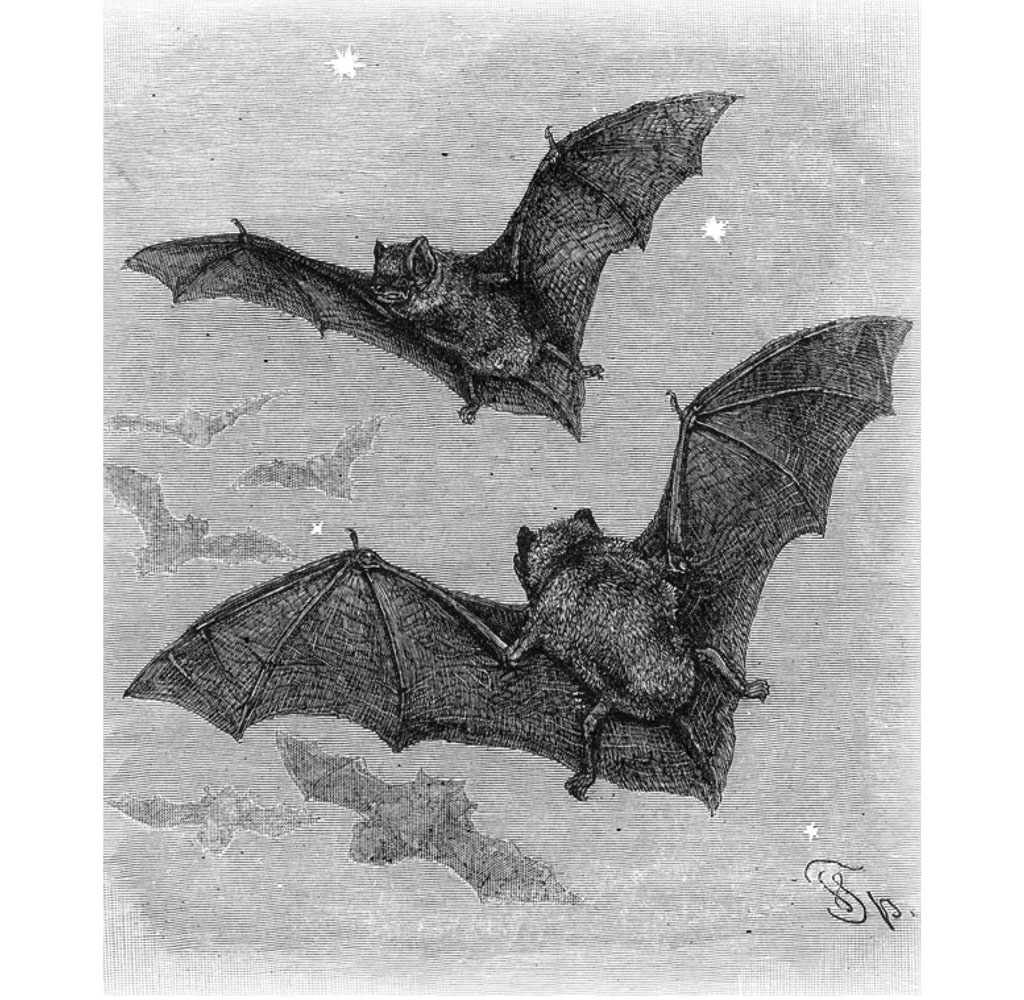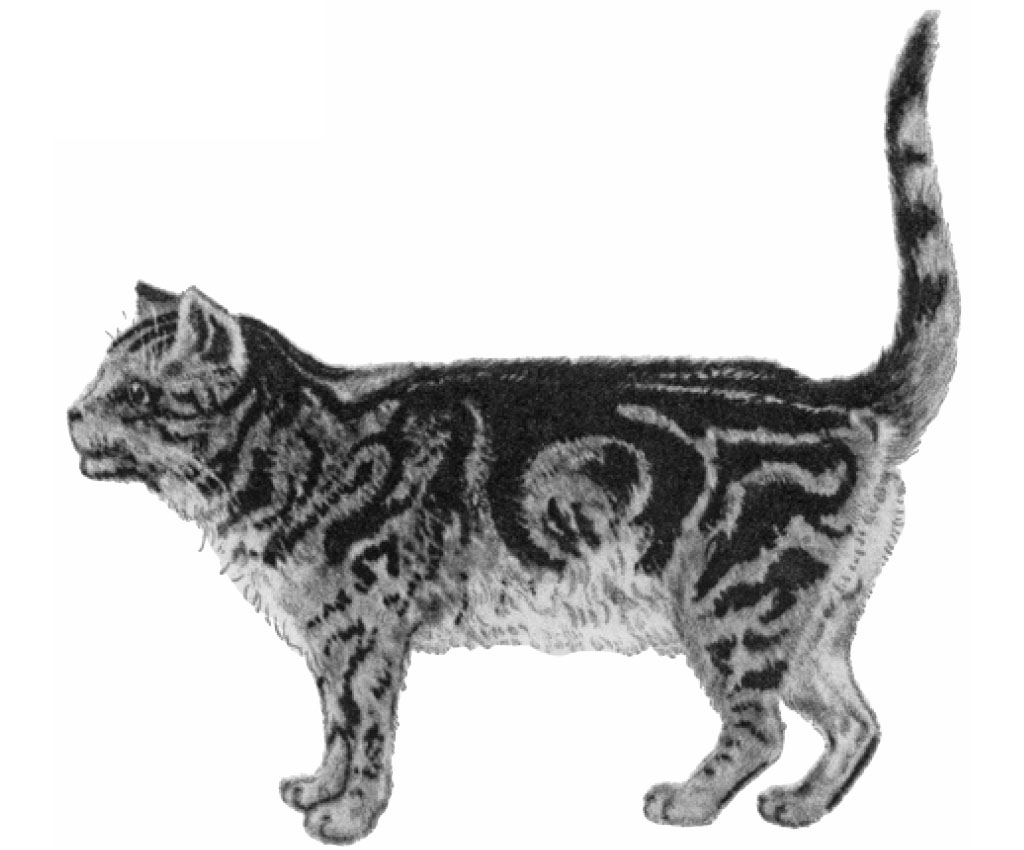
DOMESTIC CAT Felis catus
Size: Most adults 20–25cm high, 50cm long, plus 30cm tail, weight 4–5kg, but some breeds larger and heavier, to 15kg.
Description: Lithe, compact, short-necked, short-headed mammal with distinctive broad face and small, triangular ears. Despite age-long breeding of various varieties, most are of similar shape with short, thick fur, although colours and patterns vary from jet black, through tortoiseshell, tabby and marmalade, to blue, white and brown, but not green.
Life history: Litters of 3–8 young (kittens) born helpless and blind, but furred, after ten-week gestation. Weaned after seven weeks; independent after 12. Wholly meat eating; fed by humans, but also preys on small birds and mammals; will eat blowflies, moths and lizards. Sporadically active, usually at night, but much time is spent grooming or sleeping. Buries its dung away from dwelling.
Human/household impact: Associated with humans for at least 10,000 years. Descended from wild cat Felis sylvestris. Perhaps tolerated, then lauded for its control of rats and mice. Now celebrated as a companionable pet. Rarely used for fur, and even more rarely eaten by humans. Thoroughly domesticated, but with feral populations, especially in urban areas.

DOG Canis lupus familiaris
Size: Adults hugely variable, from ‘toys’ 6cm high at shoulder weighing 120g, to hunting hounds over 1m high weighing 150kg.
Description: Generally slim and relatively long-legged, short-furred mammal with large mouth, flat tongue and prominent wet nose. Bred to extremes of size, shape and body form, from stunted squat to nearly skeletal, short haired to shaggy, long or short tailed, pert to flop eared. Colours generally variations on black, brown and white.
Life history: Litters of about 4–8 young (puppies), but 2–20 known, after 8–10 weeks’ gestation; weaned after 5–8 weeks and independent soon after, but will remain in family groups much longer than will cats. Nominally meat eating, and fed animal-based foods by owners, but generally omnivorous, scavenging scraps, carrion and dung of other animals; will swallow bits of almost anything it can chew, including furniture, clothing and domestic goods. Very active diurnally. Defecates anywhere.
Human/household impact: Descended from grey wolf Canis lupus. Associated with humans for at least 30,000 years, although modern lineages derive from domestication event 15,000 years ago. Has been bred for various uses, including hunting, draught, guidance, protection, skins and food. Some modern dogs still ‘work’, but most are kept for companionship and as status symbols.

STRIPED SKUNK Mephitis mephitis
Size: Length to 45cm, plus short tail, weight 2–4kg.
Description: Small, squat, sleek, short-legged animal with fluffy, erect tail. Black, with distinct white face-stripe and prominent ‘V’-shaped white marking down back and on to tail.
Life history: Mates in spring; 4–10 blind, naked kits born seven weeks later; suckled for 6–7 weeks. General scavenger; will eat carrion, also insects, fruits including berries, and mice. If attacked can spray foul-smelling jet of acrid-scented liquid from anal glands with good accuracy to 4m, against any would-be predator, or irate householder. North America.
Human/household impact: Does no real damage to fabric of a building’s structure, but will squeeze into small hole and take up residence under building, filling entire house with intolerable odour. Can carry rabies. Similar spotted skunk Spilogale plutorius, smaller (to 26cm, 1kg), more weasel shaped and with 4–6 broken white stripes down body.
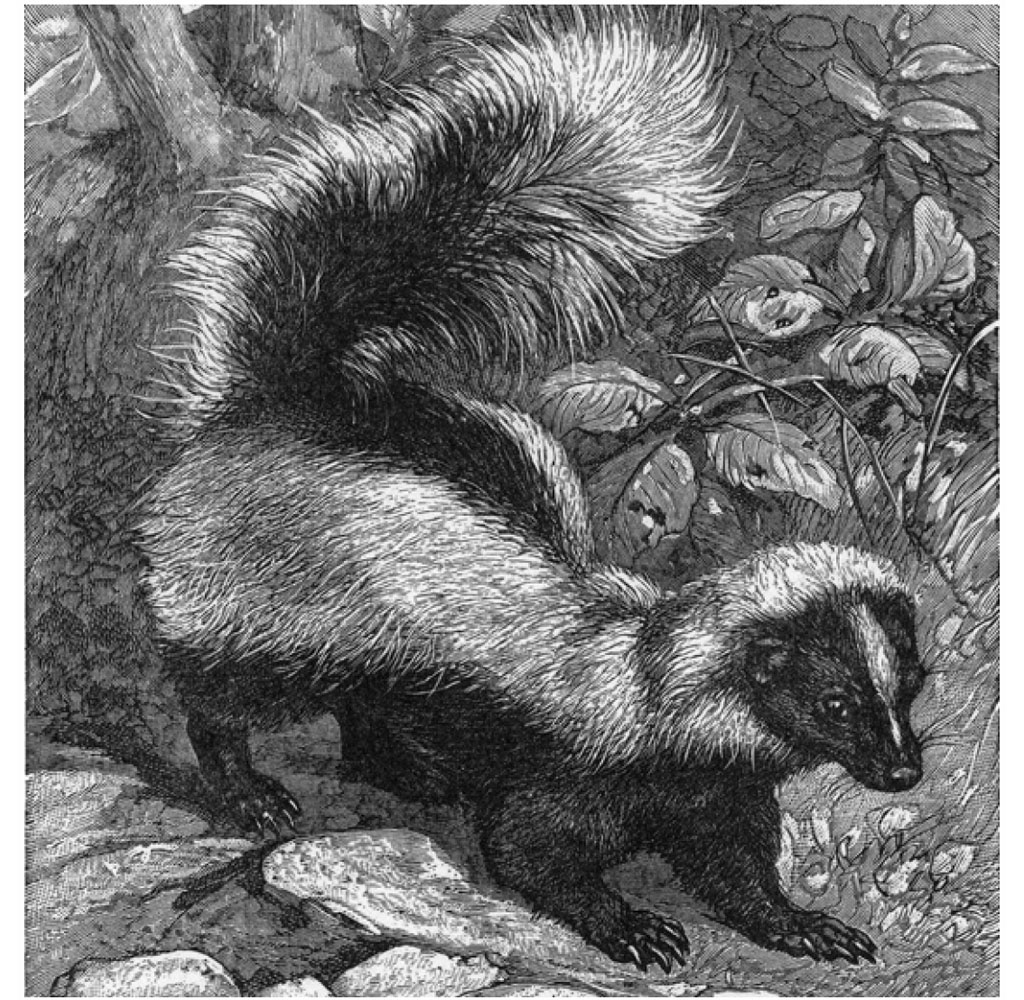
NORTH AMERICAN PORCUPINE Erethizon dorsatum
Size: Length 60–90cm, weight 5–14kg.
Description: North America’s largest rodent. Large, stout, humped body, with short tail covered all over with iconic sharp spines (quills); variously coloured, mottled, grey-brown to black, sometimes beige or yellowish.
Life history: Mates in autumn; usually one offspring born the following summer. Young remains hidden in burrow; mother climbs trees; weaned at four months. Long lived, to 18 years in the wild. Forages, often in groups; generalist herbivore, but chews bark from trees.
Human/household impact: Often comes near houses to chew wood, plastic and rubber impregnated with sweat. It is after the salt. Will burrow under buildings too.
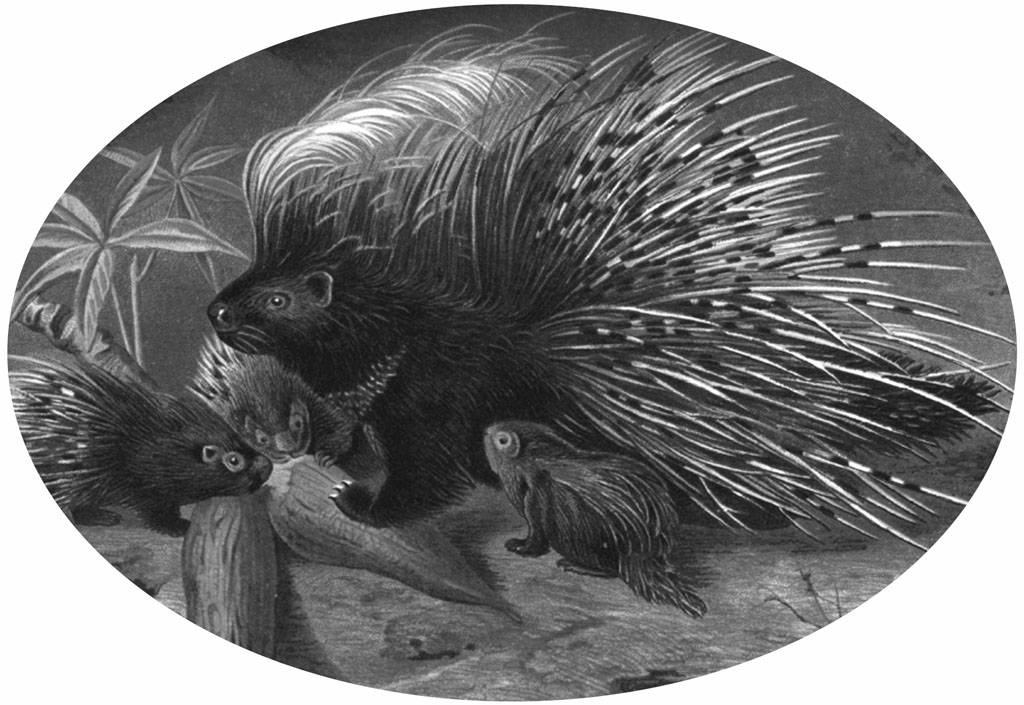
Size: Length 40–70cm, plus bushy tail, weight 2–14kg (usually 3–9kg).
Description: Long-legged, bushy-tailed and round-faced mammal, with pert ears and prehensile, hand-like paws. Mottled smoky-grey, with distinctive white face, black eye-bands and boldly ringed tail.
Life history: Litter of 2–5 kits born in summer; weaned in 6–9 weeks. Mostly nocturnal; omnivorous, eating insects, plants, berries, mice, nuts and worms. Good climber; often ‘washes’ food in water. North America, but deliberately released in Central Europe, Transcaucasia and Japan.
Human/household impact: Intelligent, curious and open to hand feeding by humans. Scavenges from bins and will enter unoccupied houses. Can carry rabies.
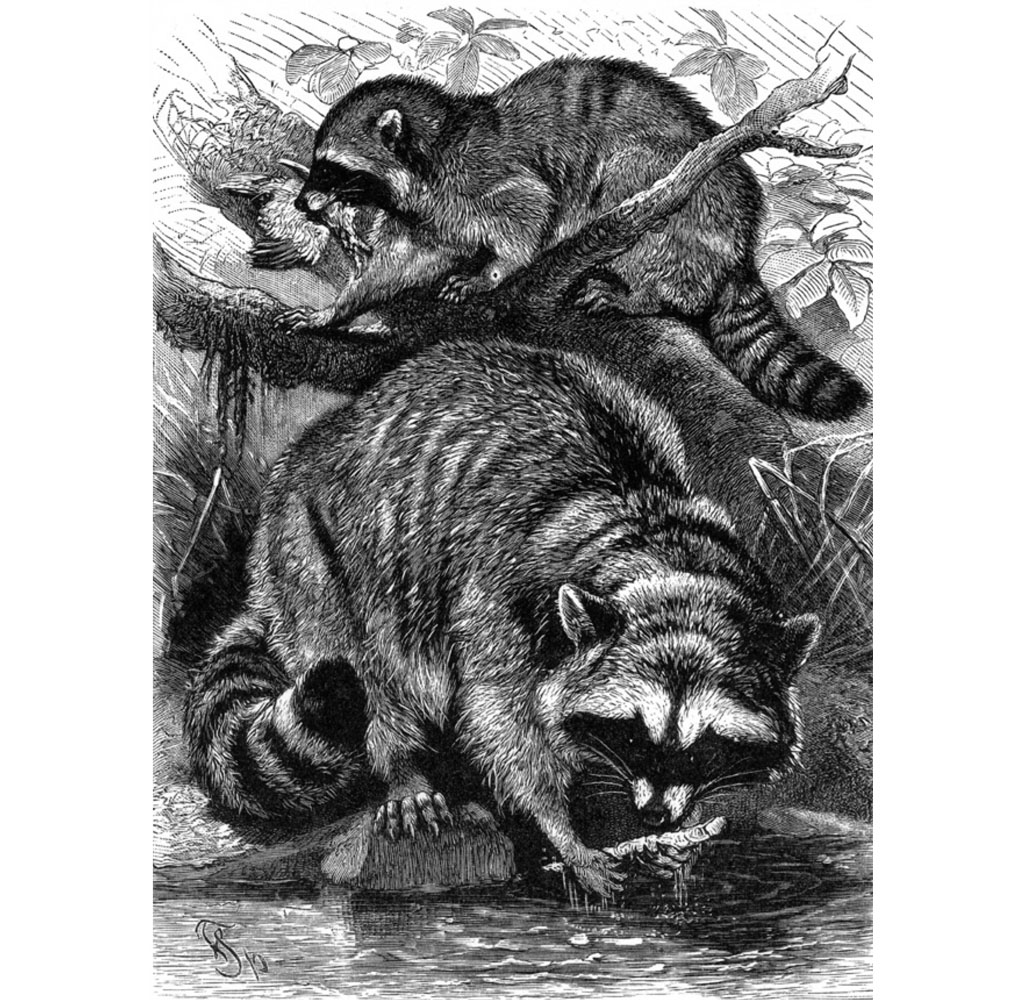
BLACK RAT (or ROOF RAT) Rattus rattus
Size: Length 16–22cm, plus 17–25cm tail, adult weight 150–230g.
Description: Long-bodied, slim, short-limbed, long-tailed mammal, with pointed snout, erect small ears, and short, thick, soft black, brown or dark grey fur.
Life history: Nests in burrow or crevice; 6–8 naked blind young born after three-week gestation. Sexually mature at four months, making them highly fecund and creating massive population explosions if conditions are right. Eats (scavenges) almost anything, especially food left out for pet or farm animals, and in rubbish.
Human/household impact: Major household, agricultural and commercial pest, eating goods, stores and just about anything else. Chews holes to get into buildings, soiling with its droppings and urine. Spreads various diseases including bubonic plague, Weil’s disease and toxoplasmosis. Thought to have arrived in Europe, through Egypt and the Near East, from India and South-east Asia during Roman times. Has since been spread throughout the world by travellers and traders, causing ecological harm to many fragile ecosystems. More of a climber than brown rat, and very much at home in roof thatch, hence its alternative common name. Slightly smaller Polynesian rat Rattus exulans dominates South-east Asia and Pacific region.

BROWN RAT (or SEWER RAT) Rattus norvegicus
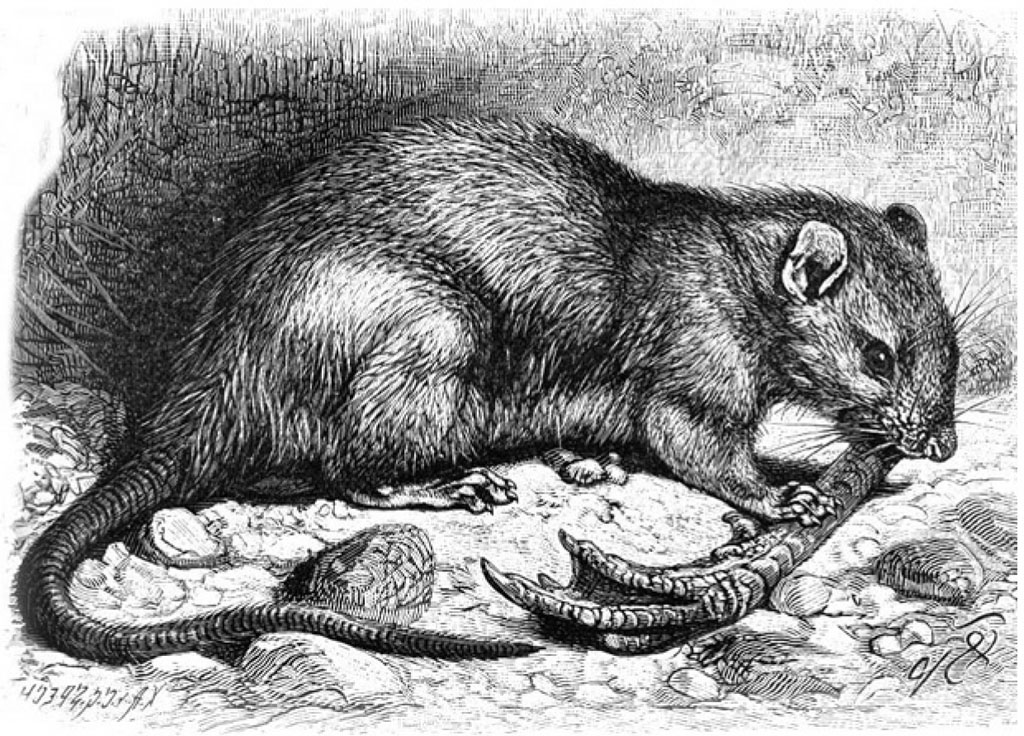
Size: Length 21–27cm, plus 16–22cm tail, adult weight 280–520g.
Description: Long-bodied, short-limbed, long-tailed mammal, with pointed head, small ears and short, thick, coarse brown fur. Larger, stouter and plumper than black rat, with smaller eyes and ears, and comparatively shorter tail compared with body.
Life history: Nests in burrow or crevice; 6–12 naked, blind young born after 3–4 weeks’ gestation; sexually mature in 2–3 months. Highly fecund. Like black rat, eats anything.
Human/household impact: Major household, agricultural and commercial pest, invading buildings and farmyards, eating everything, and chewing through and contaminating everything else. Spreads diseases including Weil’s disease, cryptosporidiosis and haemorrhagic fever. Thought to have originated in China, arriving in Europe in the Middle Ages. Scientific name coined, rather unfairly to Norwegians, because its arrival in Britain was blamed on Norwegian ships in 1728, although it was unknown in Norway at that time. Has now been spread all around the world, causing environmental havoc to countless fragile ecosystems the world over.
HOUSE MOUSE Mus musculus (sometimes M. domesticus)
Size: Length 7–10cm, plus 9–13cm tail, adult weight 12–28g.
Description: Small, delicate, slim, long-tailed, short-limbed mammal, with pointed snout and large, erect ears. Fur short and smooth, brown to almost black.
Life history: In buildings lives in wall cavities and under floorboards. Nests in nook or cranny; 5–8 blind and naked young born after three weeks’ gestation; sexually mature at seven weeks. Reproduces all year round. Eats almost anything, but prefers grain and other plant materials. Nocturnal, agile and a good climber.
Human/household impact: Major household pest, but perhaps more tolerated than rats. Thought to have originated in Asia, but arrived in the Mediterranean in about 8000 BC, and in the rest of Europe, with increasing agriculture, in around 1000 BC. Now spread throughout the globe. Has been domesticated and kept as a pet, and bred as a ‘fancy’ show animal and as a laboratory animal for medical models, drug testing and genetic studies.
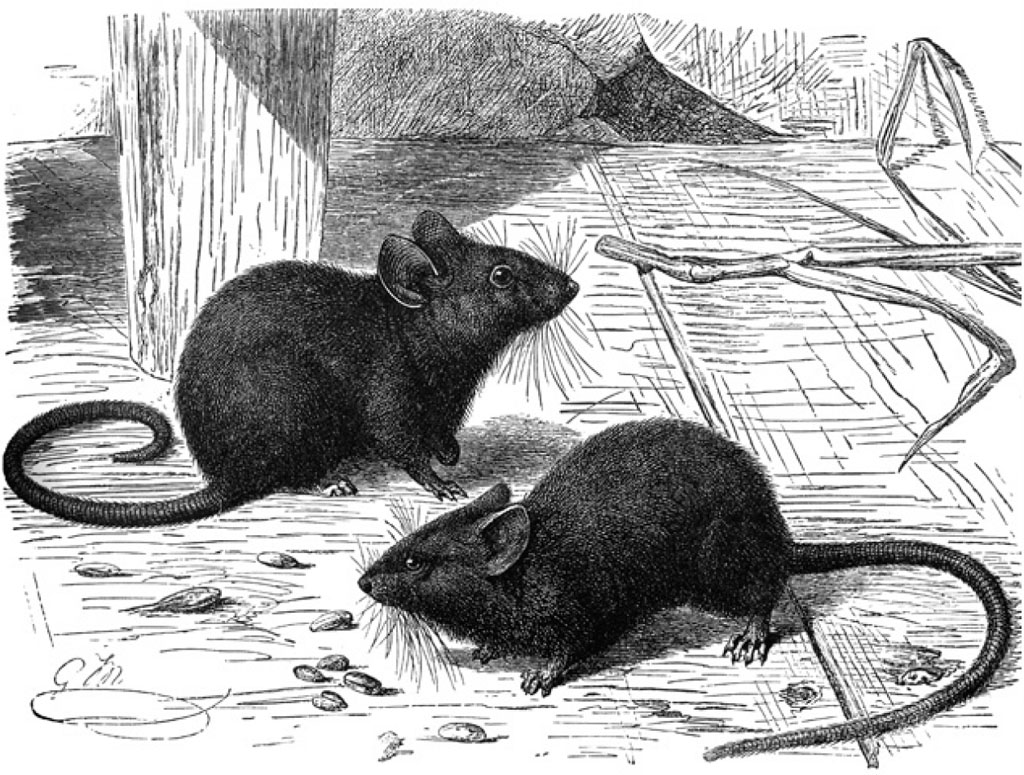
Size: Length 13–19cm, plus tail 11–15cm, adult weight 70–180g.
Description: Small, sleek and plump mammal, with prominent round ears and pointed, mouse-like snout, but fluffy, squirrel-like tail. Luxuriant fur thick, grey, with a faint yellowish tinge.
Life history: Agile climber; nests in tree hollow or burrow, lining it with moss and leaves. Hibernates September to April. Mates in June to August; 4–6 young born after four-week gestation; adult within three months. Feeds on berries and nuts; also fruits, insects and nestling birds.
Human/household impact: Normally a wild creature of mature broadleaved woodland, native to southern Europe, but spread and introduced to Britain by Romans, who kept it in semi-domesticated form for food. It subsequently died out, but was accidentally reintroduced by escapes from a private zoo at Tring. Generally a secretive woodland animal, but there are many reports of it moving into houses, nesting in lofts, cellars or even remote cupboards, and causing damage by gnawing electrical cables.

BATS order Chiroptera
Size: Length to 10cm, wingspan to 30cm.
Description: Small, round-bodied mammals, with membranous wings stretched between long-fingered arms and short legs. Body covered with short fur, wings nearly naked skin. Ears large or small, eyes small; some species with nose flattened and wrinkled, others with snout.
Life history: Nocturnal, emerging from daytime roosts to catch flying insects at dusk. Aerobatic and agile in the air, clumsy on the ground. Use high-pitched squeaks to detect flying prey by echolocation. Long hibernation during winter.
Human/household impact: Creatures of the night, so often viewed with dark suspicion, not helped by myths (ignorance) of vampire bats (rare South American species). Roost in lofts and building voids; occasional night-time scratchings, some messing with urine or droppings. Can carry rabies. Often protected species so inconvenient during loft conversions and other building work. Otherwise charming and harmless. Many similar species.
